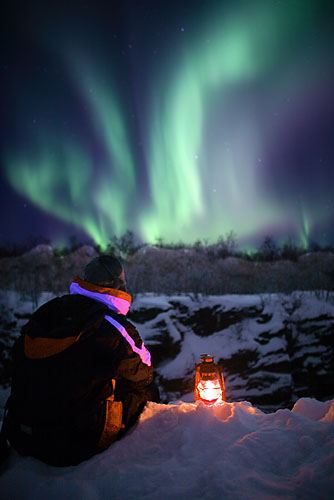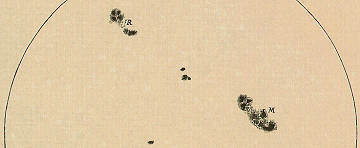 Cards, flowers, chocolate... what's missing? The heavens. Spaceweather PHONE for Valentine's Day.
Cards, flowers, chocolate... what's missing? The heavens. Spaceweather PHONE for Valentine's Day.
HAPPY BIRTHDAY, GALILEO: On February 15, 1564, Galileo Galilei was born in Pisa, Italy. If he were alive today, he would be 443 years old. Galileo is an important figure in the history of space weather. How so? Keep reading.
AURORA BOREALIS: In 1619, Galileo coined the term "aurora borealis." He thought auroras were sunlight reflected from the atmosphere, and so he named the phenomenon after Aurora, the Roman goddess of morning.
Four centuries later we know better, but Galileo's nomenclature is still used. Just yesterday, sky watchers from Scandinavia to Alaska witnessed a beautiful display of "auroras" when a solar wind stream hit Earth's magnetic field:

Photo details: Canon EOS 5D, 24 mm:1.4 lens, 4 seconds exposure.
"Great show!," says Swedish photographer Peter Rosen. "The temperature here in Abisko was minus 25 degrees, but Aurora kept me warm."
February Aurora Gallery
[aurora alerts] [night-sky cameras]
BONUS: "I live in Pisa, Italy," says photographer Riccardo Di Nasso, "and the house where Galileo was born is still standing." He photographed himself in front of Galileo's "Casa Ammannati" earlier today: image.
SUNSPOTS: Contrary to popular belief, Galileo did not discover sunspots, but he was one of the first to observe them using a telescope. In Galileo's day, many people believed sunspots were satellites of the sun. Galileo proved otherwise. By drawing sunspots every day, he discovered that the sun spins and that sunspots must be located on or close to the sun's surface. Personally, Galileo thought sunspots were clouds.

Above: Sunspots drawn by Galileo in June 1612: more.
Now we know what sunspots really are: great islands of magnetism. Sunspots consist of magnetic force fields poking through the sun's surface. These fields block the flow of heat from below, cooling the sun in their vicinity. Because sunspots are so cool, "only" a few thousand degrees, they appear dark compared to the surrounding inferno.
If Galileo were with us today, he wouldn't be impressed. The sun is utterly blank. 2007 is a year of solar minimum, and sunspots are somewhat rare. A better birthday would be the year 2010 when Solar Max comes roaring back. Stay tuned--and many happy returns.
BONUS: To celebrate Galileo's birthday, John Stetson of Falmouth, Maine, created this beautiful composite of spiral sunspot 940, which he photographed crossing the sun recently. Galileo never saw anything like that!

